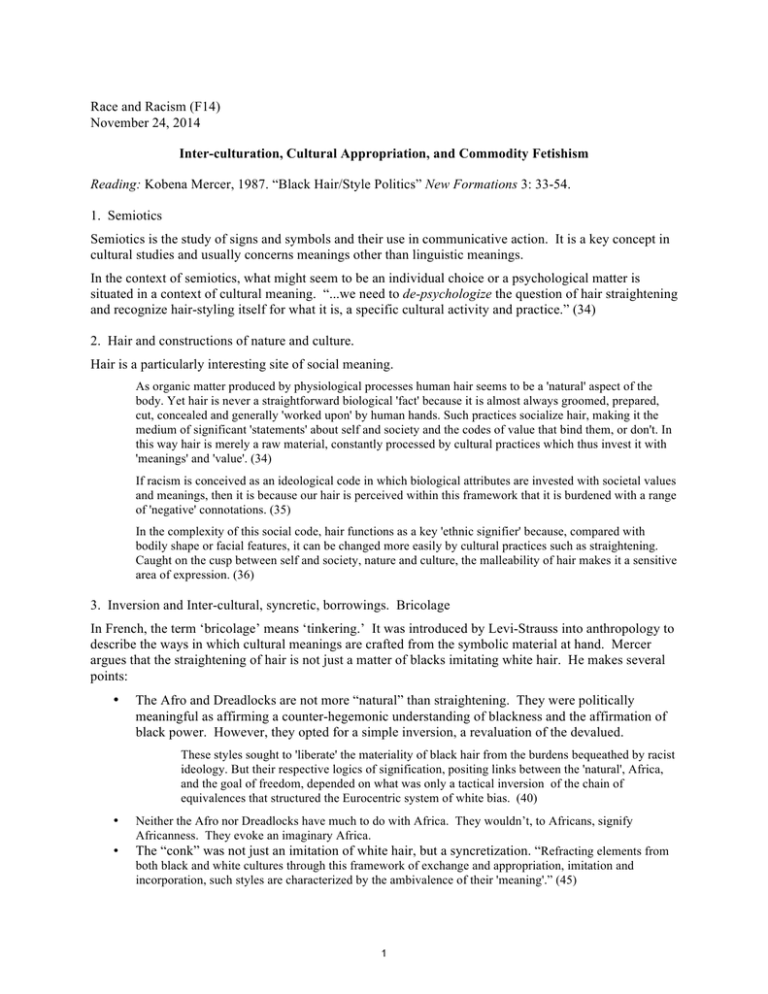Document 13523987
advertisement

Race and Racism (F14) November 24, 2014 Inter-culturation, Cultural Appropriation, and Commodity Fetishism Reading: Kobena Mercer, 1987. “Black Hair/Style Politics” New Formations 3: 33-54. 1. Semiotics Semiotics is the study of signs and symbols and their use in communicative action. It is a key concept in cultural studies and usually concerns meanings other than linguistic meanings. In the context of semiotics, what might seem to be an individual choice or a psychological matter is situated in a context of cultural meaning. “...we need to de-psychologize the question of hair straightening and recognize hair-styling itself for what it is, a specific cultural activity and practice.” (34) 2. Hair and constructions of nature and culture. Hair is a particularly interesting site of social meaning. As organic matter produced by physiological processes human hair seems to be a 'natural' aspect of the body. Yet hair is never a straightforward biological 'fact' because it is almost always groomed, prepared, cut, concealed and generally 'worked upon' by human hands. Such practices socialize hair, making it the medium of significant 'statements' about self and society and the codes of value that bind them, or don't. In this way hair is merely a raw material, constantly processed by cultural practices which thus invest it with 'meanings' and 'value'. (34) If racism is conceived as an ideological code in which biological attributes are invested with societal values and meanings, then it is because our hair is perceived within this framework that it is burdened with a range of 'negative' connotations. (35) In the complexity of this social code, hair functions as a key 'ethnic signifier' because, compared with bodily shape or facial features, it can be changed more easily by cultural practices such as straightening. Caught on the cusp between self and society, nature and culture, the malleability of hair makes it a sensitive area of expression. (36) 3. Inversion and Inter-cultural, syncretic, borrowings. Bricolage In French, the term ‘bricolage’ means ‘tinkering.’ It was introduced by Levi-Strauss into anthropology to describe the ways in which cultural meanings are crafted from the symbolic material at hand. Mercer argues that the straightening of hair is not just a matter of blacks imitating white hair. He makes several points: • The Afro and Dreadlocks are not more “natural” than straightening. They were politically meaningful as affirming a counter-hegemonic understanding of blackness and the affirmation of black power. However, they opted for a simple inversion, a revaluation of the devalued. These styles sought to 'liberate' the materiality of black hair from the burdens bequeathed by racist ideology. But their respective logics of signification, positing links between the 'natural', Africa, and the goal of freedom, depended on what was only a tactical inversion of the chain of equivalences that structured the Eurocentric system of white bias. (40) • • Neither the Afro nor Dreadlocks have much to do with Africa. They wouldn’t, to Africans, signify Africanness. They evoke an imaginary Africa. The “conk” was not just an imitation of white hair, but a syncretization. “Refracting elements from both black and white cultures through this framework of exchange and appropriation, imitation and incorporation, such styles are characterized by the ambivalence of their 'meaning'.” (45) 1 4. Commodity Fetishism The Afro, Dreadlock, etc., because they relied on a simple inversion of the binary, were “rapidly assimilated and dissimulated by commodity fetishism.” (42) Commodity fetishism is a process by which things are imbued with value and that value is taken to be intrinsic to them, although its source is in, e.g., the labor put into making it. In the context of semiotics, the idea is that things are taken to be inherently meaningful, whereas the source of their meaning is in the ways they manage and define social relations. Black practices of aesthetic stylization are intelligible at one 'functional' level as dialogic responses to the racism of the dominant culture, but at another level involve acts of appropriation from that same 'master' culture through which 'syncretic' forms of diasporean culture have evolved. Syncretic strategies of black stylization, 'creolizing' found or given elements, are writ large in the black codes of modern music like jazz where elements such as scales, harmonies or even instruments like the piano or saxophone from western cultural traditions are radically transformed by this 'neo-African', improvisational approach to aesthetic and cultural production. In addition there is another 'turn of the screw' in these modern relations of interculturation when these creolized cultural forms are made use of by other social groups and then, in turn, are all incorporated into mainstream 'mass' culture as commodities for consumption. (45) The complexity of this force-field of inter-culturation ambushes any attempt to track down fixed meanings or finalized readings and opens out instead on to ambiguous relations of economic and aesthetic systems of valorization. On the one hand, the conk was conceived in a subaltern culture, dominated and hedged in by a capitalist master culture, yet operating in an 'underground' manner to subvert given elements by creolizing stylization. Style encoded political 'messages' to those in the know which were otherwise unintelligible to white society by virtue of their ambiguous accentuation and intonation. But, on the other hand, that dominant commodity culture appropriated bits and pieces from the otherness of ethnic differentiation in order to reproduce the 'new' and so, in turn, to strengthen its dominance and revalorize its own symbolic capital. (49) Conclusion/Qualification? This article has prioritized the semiotic dimension in its readings to open up analyses of this poly vocal economy but there are other facets to be examined: such as the exploitative priorities of the black hairdressing industry as it affects consumers, or workers under precarious market conditions, or the question of gendered differentiations (and similarities). (53) Questions: 1. If syncretization and bricolage is inevitable when cultures co-exist, how do we distinguish the good cases from the bad cases, the legitimate from the illegitimate/wrongful/unjust? Note that cultural “borrowing” can be: • • • A form of assimilation v. a form of resistance/problemitization A form of admiration v. a form of parody A form of exploitation (economic, cultural plagiarism) v. dialogue/collaboration How do we distinguish these? 2. What is assimilation? Is assimilation always bad? In what sense good or bad? Mercer, Kobena. “Black Hair / Style Politics.” New Formations 3 (1987): 33-54. © Lawrence & Wishard Ltd. All rights reserved. This content is excluded from our Creative Commons license. For more information, see http://ocw.mit.edu/help/faq-fair-use/. 2 MIT OpenCourseWare http://ocw.mit.edu 24.236 Topics in Social Theory and Practice: Race and Racism Fall 2014 For information about citing these materials or our Terms of Use, visit: http://ocw.mit.edu/terms.





